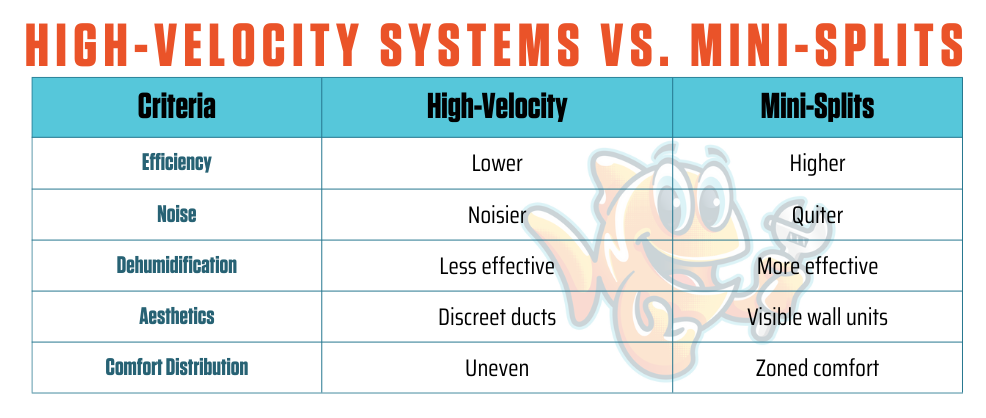|
Getting your Trinity Audio player ready...
|
Last Revised: 5/9/25
Have you been told a high-velocity HVAC system might be right for your home – but you’re not sure what that even means? Are you frustrated by limited space, no ductwork, or the idea of hanging bulky mini-split heads in every room?
At Mattioni, we’ve spent decades helping homeowners make smart HVAC choices based on real performance, not hype. While high-velocity systems can be a great fit in certain homes, they also come with big trade-offs that most companies don’t talk about.
In this article, we’ll break down what high-velocity HVAC systems are, where they work best, and why they’re often not the first choice anymore. By the end, you’ll know whether this is the right solution for your home – or if there’s a better option that delivers quieter, more efficient comfort. Let’s start with a closer look at how high-velocity HVAC systems operate.
What is a High-Velocity HVAC System?
Heads-up: Technical jargon incoming
A high-velocity system uses the same core principles as traditional air conditioners or heat pumps, but it delivers air through much smaller ducts at higher speeds. While a standard system typically moves about 400 CFM (cubic feet per minute) of air per ton, high-velocity systems operate at nearly half that – around 200 CFM per ton.
This lower airflow results in less air moving across the indoor coil, and therefore more heat is absorbed. In effect, the temperature difference between supply and return air is about 10-15°F greater than traditional systems.
To manage this, high-velocity systems use compact, 2” ducts and are designed to push air through your home at a much faster pace than traditional AC or heat pumps. These smaller ducts allow them to be routed through much tighter spaces where standard ducts can’t go.
If that left you scratching your head, you’re not alone. Think of a high-velocity HVAC system like using a pressure washer instead of a garden hose. Both move water, but the pressure washer uses a narrower nozzle to deliver less water at a much higher speed. Similarly, high-velocity systems move less air through smaller ducts, but do it faster and with more force.
Where High-Velocity Systems Work Best
High-velocity HVAC systems are most commonly used in older homes, urban row homes, or historic properties where space is limited and conventional ductwork is impractical. Their small, flexible ducting can be snaked through walls, closets, or chases with minimal construction impact – something not easily achieved with traditional 6-8” ducts.
They also appeal to homeowners who prefer not to have wall-mounted mini-split units visible in their spaces. In these cases, high-velocity systems offer a more discreet way to get whole-home cooling without altering the aesthetics of the home.
Pros of High-Velocity HVAC Systems
1. Compact Ductwork & Spatial Savings
Perhaps the biggest advantage of high-velocity systems is the size of the ductwork. These systems use thin, flexible tubing that can be routed through tight spaces without major structural modifications. This makes them an option for retrofit installations in homes without existing ductwork.
2. Aesthetic Flexibility
Unlike mini-splits, which often require noticeable indoor units, high-velocity systems keep all components tucked near walls and ceilings. This appeals to homeowners who prioritize clean, uninterrupted interior design.
3. Effective for Retrofitting
If a home already has an older high-velocity system, replacing it with a new one may be more cost-effective than switching to a completely different HVAC setup (like a mini-split), especially if the existing ducts are in good condition.
Cons and Limitations of High-Velocity HVAC Systems to Consider
While there are a few key advantages to this type of system, there are several drawbacks to be mindful of before choosing one for your home.
1. Lower Efficiency
High-velocity systems are generally less efficient than both standard central AC systems and modern mini-split systems. In fact, they’re substantially less efficient than mini-splits. Since they rely on higher static pressures and reduced airflow, they can consume more energy, especially if not sized or installed correctly.
2. Noisier Operation
They’re also much noisier than comparable systems (like mini-splits) as air exits the vents with force, causing an audible rush of cool air. This can turn the otherwise inconspicuous 2” ducts into a distraction when the system turns on.
3. Uneven Air Circulation & Comfort
High-velocity systems often produce cold blasts near vents but uneven temperatures everywhere else. This can make for a frustrating user experience as you try to get your whole home comfortable.
4. Less Dehumidification
Their ability to dehumidify lags behind that of mini-splits, which can run for longer cycles and often include dedicated humidity control modes.
5. Requires Backup Heating
High-velocity systems often need supplemental heating during colder months. In the Northeast region, this typically means integrating it with electric heat strips or a hydronic coil from an existing boiler. This adds to the system’s complexity and operating costs.
High-Velocity HVAC vs. Mini-Splits: Which is Better?
While high-velocity systems once solved a unique problem for homes without ductwork and with spatial concerns, newer mini-split technologies have largely surpassed them in performance, energy savings, and homeowner satisfaction.

Should You Install a High-Velocity HVAC System in Your Home?
Now that you understand how high-velocity HVAC systems work, you can see why they’re a smart choice for some – but far from perfect for most.
If you’re working with a tight retrofit, they can get the job done. But compared to modern ductless options like mini-splits, they often fall short on comfort, efficiency, and noise control. Still, every home is different – and we’re here to help you figure out what makes the most sense for yours.
Whether you’re looking to replace an existing high-velocity system or explore quieter, more efficient alternatives, we’ll walk you through your options with zero pressure. We’ve helped thousands of homeowners solve tough HVAC challenges with honesty and clarity – and we’d love to do the same for you.
Call us today at (610) 400-8510 or book online to get expert advice tailored to your home, your space, and your goals.




